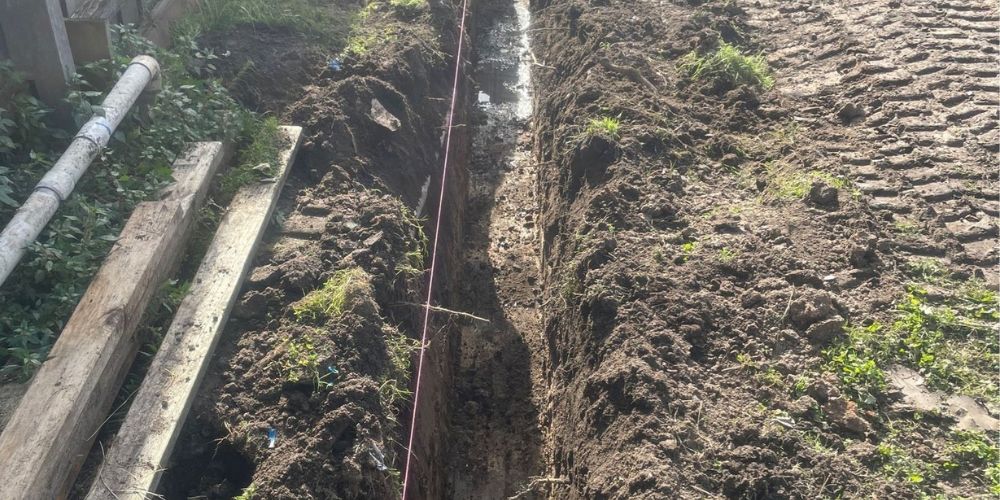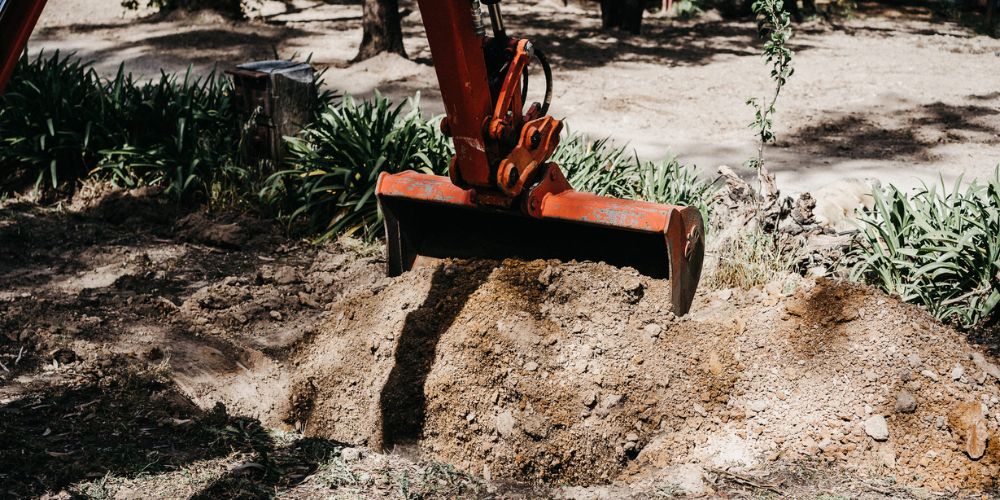Table of Contents
A Guide To Trenching With An Excavator
Excavators are a necessary component of any construction, building, or mining project. Excavators, which are designed for heavy-duty trenching and hauling, can increase your team’s efficiency and productivity while also lowering your operating costs. Excavators come in a variety of types and sizes and can be used for a variety of tasks, including breaking ground, digging trenches, lifting heavy materials, crushing pavement, and more.
Excavator operation while trenching can have a significant impact on productivity. Planning ahead of time will improve performance, reduce the risk of accidents, and boost productivity. Failure to plan your approach to the excavation is one of the most common mistakes. Bottlenecks in the process can cause the material to be moved more than once. So let’s dive into and see how to minimize the mistakes and increase the efficiency of the trenching process.

Procedures for Efficient Trenching
Before Starting The Process
Before you dig, you must know what is beneath the ground if you are excavating existing pipes and electrical cables or installing new lines. To find out where gas, water, sewage, and electrical lines are located, contact your local utility companies. It is also critical to identify and locate all existing power lines and pipes in the area. New pipes should always be placed at least 500 mm away from existing pipelines.
You should start building the trench until you realize there won’t be any pipes or lines in the direction. Determine the depth and width of the trench, as well as its length. Then you can determine what kind of equipment and shoring materials will be needed.
Make a plan for the length, depth, and placement.
Before you go hacking into the earth with whatever digging equipment you’re using, you should have a plan. You can easily map out the path of your trench – simply determine the length and width of your trench, then mark the outline with stakes and string.
Identifying potential hazards such as soft-spots and drop-offs is also important. It’s also worth looking at nearby trees and considering their root systems, as these could pose a threat to your trench.
Choose the Proper Equipment
A compact excavator is one of the most efficient ways to quickly dig a trench. These have a smaller footprint than any other option, requiring less space on the job site to accommodate your equipment. These are also ideal for the limited space available in a backyard or other residential setting. The knuckle boom and pivoting cab allow for easy maneuverability, and the arm on the strongest models can support up to 18,500 pounds.
Conduct an Excavator Inspection
Perform a thorough inspection of the excavator before using it. Refill the engine coolant and oil levels. Look for loose connections or split lines in hydraulic hoses. Lubricate pivot points as well. Familiarize yourself with the excavator controls so that you can operate the machine efficiently.
If you are a residential homeowner who has never used an excavator before, consider hiring a professional who can do the job safely. An experienced excavator can operate the controls correctly. Heavy equipment rental companies can provide operators on an hourly basis for a minimum of 4 to 6 hours.
Removal of the Topsoil Layer
Carefully remove the topsoil layer, up to a depth of 4 to 8 inches, as it will be returned to the area after the trench is back filled. Keep it separate from the rest of the earthen materials that will be excavated to avoid contamination. If you plan to store the topsoil layer for an extended period of time due to the length of the excavation project, you can overseed it.
Dig to the desired depth for the first cut.
The first cut into the earth should be made all the way down to the desired depth of the trench. Dig into the soil, removing it in layers until you reach the required depth. If the trench is to be dug to a greater depth, the excavation must be benched.
Benching entails digging in tiers and removing twice as much soil as the actual trench width wise. This technique is used to relieve the load pressure on the trench walls caused by the soil. Typically, a wider shovel bucket is used on the excavator machine to create the bench at 2 to 3-foot intervals.
Examine the Soil Conditions
The soil conditions can influence how long it takes to dig the trench and whether the trench walls can support the weight of the soil. You can also see if there will be a lot of surface water entering the trench and making the trench walls unstable. Consider using these trench wall techniques to keep workers safe and the trench from collapsing.
- Trench depths greater than 3 feet: Shore trench walls constructed with plywood sheets and posts.
- Benching should be done along the sides of the trench if the soil is loose.
- Large Trenches Deeper Than 3 Feet: Install sheet pilings and steel trench boxes.
- Water surplus: Set up a diaphragm pump and a sock pipe to divert and remove water from the trench.
Final Step
The final stage of trench excavation entails installing the project’s wiring or pipework if any. Then, remove the plywood or steel trench boxes that were used to reinforce the trench walls and back fill the trench with the removed soil. If the trench is deep, you should fill it in layers and then tamp it down. So you can fill in the trench with 8 to 10 inches of soil and compact it before adding the next layer.
Change Filters When Necessary
Filters on excavators may have different service intervals. When a filter is dirty or completely clogged, it can have a direct impact on performance and jeopardize sensitive components. The majority of industry excavators have air filter restriction indicators that alert operators to the need for maintenance.
It is critical not to remove the filter until the required time has passed in order to avoid system contamination. Recheck filter maintenance according to the manufacturer’s service schedule.

Safety Precautions With An Excavator
Excavators have a lot of safety features, but that doesn’t mean they’ll always get the job done. To make full use of the features and ensure the safety of yourself and others around you, good judgement is always required.
When using an excavator, there are a few safety considerations to keep in mind.
- Excavators only have one seat, which should be occupied by the operator; no one else should be allowed in the bucket, cab, or anywhere else on the machine.
- Match your speed to the demands of the job.
- When working on rough terrain or in congested areas, the excavator’s speed should be reduced.
- During transportation, the bucket should be kept lower to the ground to improve visibility and machine stability.
- When moving the excavator around the Job site, the flat route should be chosen as much as possible.
- When turning, the equipment should be driven as straight as possible and only small gradual changes in direction should be made.
- Instead of moving diagonally up the slopes, the equipment should be moved vertically.
- When trenching the equipment should be leveled by placing dirt beneath the tracks.
- You should work with the propel motors at the back of the machine to achieve better stability.
- To avoid cave-ins, the soil should be dumped as far away from the excavation site as possible.
- If excavation is required on a slope, the machine should be levelled by digging a shelf (or a bench cut).
- When casting down a steep bench cut, you must cut far enough away from the upper bank to allow for adequate swing clearance.
If you want to extend the life of your excavator and avoid dangerous injuries to men and machines, keep these excavator safety tips in mind. These small but crucial suggestions can significantly boost machine productivity and efficiency.
What Excavator Size Should You Use?
With so many different excavator types and sizes to choose from, selecting the right excavator for your project requires some thought. The right excavator will give you the power and strength you need to complete the job quickly and at the lowest possible cost. You can increase your productivity by taking the time to select the appropriate excavator size.
- Consider the project’s and work site’s requirements when making your selection.
- Consider the types of projects you typically undertake when purchasing an excavator for long-term use.
- Select an excavator that will meet your most common job requirements and perform well on the job sites.
Final Thoughts
Construction workers’ lives have unquestionably been made easier by excavators. What used to take weeks, if not months, now takes only a day or two. These machines, on the other hand, can be extremely dangerous to both the excavators and the structures or utilities in the area. Understanding the dangers and how to avoid them can help you keep your workplace safe.
